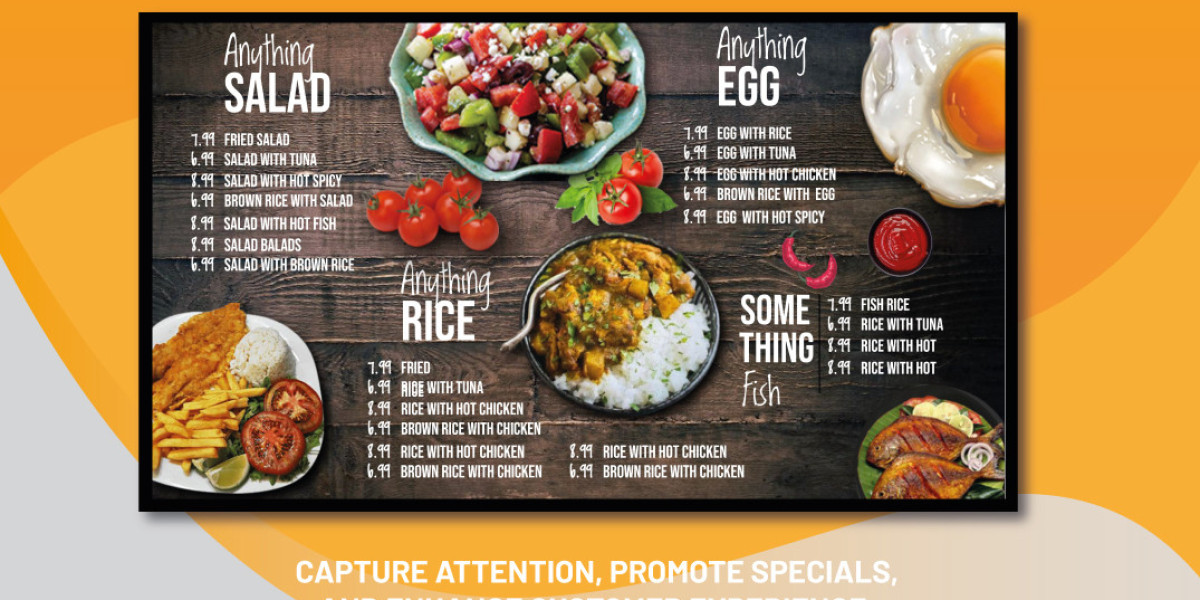In the ever-evolving world of the restaurant industry, staying ahead of the competition means embracing innovation and adapting to the latest technologies. One such technological advancement that has taken the dining experience to new heights is the restaurant digital menu board.
The Rise of the Digital Menu Board
What is a Restaurant Digital Menu Board?
A restaurant digital menu board is an electronic display that replaces traditional printed menus. These boards use LED or LCD screens to showcase menu items, prices, promotions, and other relevant information. The content can be easily updated and customized through specialized software, allowing restaurant owners to manage their menus in real time.
Evolution of Menu Displays
The transition from static printed menus to dynamic digital displays represents a significant shift in how restaurants communicate with their customers. Early adopters of digital menu boards recognized the potential for increased efficiency and enhanced customer engagement. Today, digital menu boards are commonplace in quick-service restaurants (QSRs), cafes, and even fine dining establishments.
Advantages of Restaurant Digital Menu Boards
Enhanced Customer Experience
One of the primary benefits of digital menu boards is their ability to enhance the customer experience. These boards can display high-quality images and videos of menu items, making them more appealing and easier for customers to make decisions. Additionally, digital menus can include nutritional information, allergy warnings, and ingredient lists, catering to the needs of health-conscious diners.
Increased Sales and Upselling Opportunities
Digital menu boards can significantly boost sales through strategic content placement and dynamic displays. By highlighting promotions, combos, and limited-time offers, restaurants can entice customers to spend more. Animated visuals and attention-grabbing designs can draw attention to high-margin items, encouraging upselling and cross-selling.
Operational Efficiency
Updating printed menus can be time-consuming and costly, especially for restaurants with frequently changing offerings. Digital menu boards eliminate these challenges by allowing instant updates. Whether it's a price change, a new item, or a sold-out dish, modifications can be made quickly and remotely, ensuring consistency across all locations.
Brand Consistency
For restaurant chains and franchises, maintaining brand consistency is crucial. Digital menu boards ensure that all locations display the same high-quality visuals and adhere to branding guidelines. This uniformity reinforces brand identity and creates a cohesive customer experience, regardless of the restaurant's location.
Cost Savings
While the initial investment in digital menu boards may be higher than traditional menus, the long-term cost savings are significant. Eliminating the need for printed materials reduces printing and distribution costs. Additionally, digital boards are durable and require less frequent replacement compared to printed menus, further reducing expenses.
Key Features of Restaurant Digital Menu Boards
High-Resolution Displays
Modern digital menu boards boast high-resolution displays that can showcase vibrant images and videos. This visual clarity enhances the appeal of menu items and captures the attention of customers, ultimately driving sales.
Dynamic Content Management
The ability to manage content dynamically is a standout feature of digital menu boards. Restaurant owners can schedule content updates, rotate menu items based on time of day, and display special promotions. This flexibility allows for more personalized and targeted marketing strategies.
Integration with POS Systems
Integration with point-of-sale (POS) systems streamlines operations by ensuring that menu updates are reflected accurately and in real-time. This synchronization minimizes errors and enhances the overall efficiency of the restaurant.
Interactive Touchscreens
Some digital menu boards come equipped with interactive touchscreen capabilities. These touchscreens enable customers to browse the menu, customize their orders, and even make payments directly through the display. This interactivity enhances the customer experience and can reduce wait times.
Remote Management
For restaurant chains with multiple locations, remote management capabilities are essential. Digital menu boards can be controlled from a central location, allowing for consistent updates and monitoring across all outlets. This feature is particularly beneficial for maintaining brand consistency and implementing coordinated marketing campaigns.
Implementing Digital Menu Boards in Your Restaurant
Assessing Your Needs
Before investing in digital menu boards, it's essential to assess your restaurant's specific needs and goals. Consider factors such as the size of your establishment, the type of cuisine you offer, and your target audience. Understanding these aspects will help you choose the right digital menu board solution.
Choosing the Right Hardware
Selecting the appropriate hardware is crucial for the successful implementation of digital menu boards. Factors to consider include screen size, resolution, and durability. For outdoor installations, ensure the displays are weather-resistant and have high brightness levels for visibility in sunlight.
Content Creation and Management
Creating compelling content is key to maximizing the benefits of digital menu boards. Invest in high-quality images and videos of your menu items. Additionally, consider hiring a professional graphic designer to ensure that your content is visually appealing and aligns with your brand identity.
Software Solutions
Choosing the right software is equally important. Look for software solutions that offer user-friendly interfaces, content scheduling, and remote management capabilities. Some software options also provide analytics and reporting features, allowing you to track the effectiveness of your digital menu boards.
Installation and Maintenance
Proper installation is critical to ensure that your digital menu boards function optimally. Consider hiring professional installers with experience in digital signage. Regular maintenance, such as cleaning the screens and updating the software, will prolong the lifespan of your digital menu boards and keep them running smoothly.
Impact of Digital Menu Boards on the Restaurant Industry
Enhanced Marketing Capabilities
Digital menu boards open up new avenues for marketing and customer engagement. Restaurants can leverage these boards to promote special offers, loyalty programs, and events. The ability to display dynamic content allows for more creative and effective marketing strategies.
Data-Driven Decision Making
Many digital menu board software solutions come with analytics capabilities that provide valuable insights into customer behavior. By analyzing data such as popular menu items, peak ordering times, and customer preferences, restaurant owners can make informed decisions to optimize their menu and operations.
Improved Customer Satisfaction
Digital menu boards contribute to improved customer satisfaction by offering a more streamlined and engaging ordering experience. The ability to quickly update menus ensures that customers always have access to the most accurate information, reducing confusion and enhancing the overall dining experience.
Sustainability and Environmental Impact
By reducing the need for printed menus, digital menu boards contribute to sustainability efforts in the restaurant industry. This eco-friendly approach aligns with the growing consumer demand for environmentally responsible practices.
Case Studies: Success Stories
McDonald's
McDonald's, one of the world's largest fast-food chains, has successfully implemented digital menu boards in its restaurants worldwide. The digital displays have allowed McDonald's to streamline its menu updates, promote limited-time offers, and enhance the overall customer experience. The result has been increased sales and improved operational efficiency.
Starbucks
Starbucks has leveraged digital menu boards to create a more dynamic and engaging in-store experience. The coffee giant uses these boards to highlight seasonal drinks, showcase nutritional information, and promote loyalty programs. The flexibility of digital menu boards has enabled Starbucks to maintain brand consistency across its global locations.
Local Pizzerias
Even small, independent pizzerias have benefited from digital menu boards. By showcasing mouth-watering images of their pizzas and highlighting daily specials, these establishments have seen increased foot traffic and higher sales. The ability to quickly update the menu based on ingredient availability has also improved operational efficiency.
Future Trends in Restaurant Digital Menu Boards
Artificial Intelligence and Personalization
The future of digital menu boards lies in the integration of artificial intelligence (AI) and personalization. AI-powered systems can analyze customer data to display personalized menu recommendations based on individual preferences and ordering history. This level of personalization can significantly enhance the customer experience and drive sales.
Augmented Reality (AR) Integration
Augmented reality (AR) integration is another exciting trend in digital menu boards. AR can provide customers with interactive and immersive experiences, such as visualizing how a dish will look on their table or exploring ingredients in 3D. This technology adds a new dimension to the dining experience and sets restaurants apart from the competition.
Voice-Activated Ordering
Voice-activated ordering systems are becoming increasingly popular in the restaurant industry. Integrating voice recognition technology with digital menu boards allows customers to place orders verbally, reducing wait times and enhancing convenience. This technology is particularly beneficial for drive-thru restaurants and busy urban locations.
Sustainability and Energy Efficiency
As sustainability continues to be a priority, future digital signage software will focus on energy efficiency and eco-friendly materials. Advances in technology will lead to displays that consume less power and have a longer lifespan, further reducing the environmental impact of digital signage.
Conclusion
The restaurant digital menu board is revolutionizing the way restaurants operate and interact with customers. From enhancing the customer experience and increasing sales to improving operational efficiency and promoting sustainability, the benefits of digital menu boards are undeniable. As technology continues to evolve, we can expect even more innovative features and applications that will further transform the dining landscape. For restaurants looking to stay competitive and meet the demands of modern diners, embracing digital menu boards is not just an optionit's a necessity.








